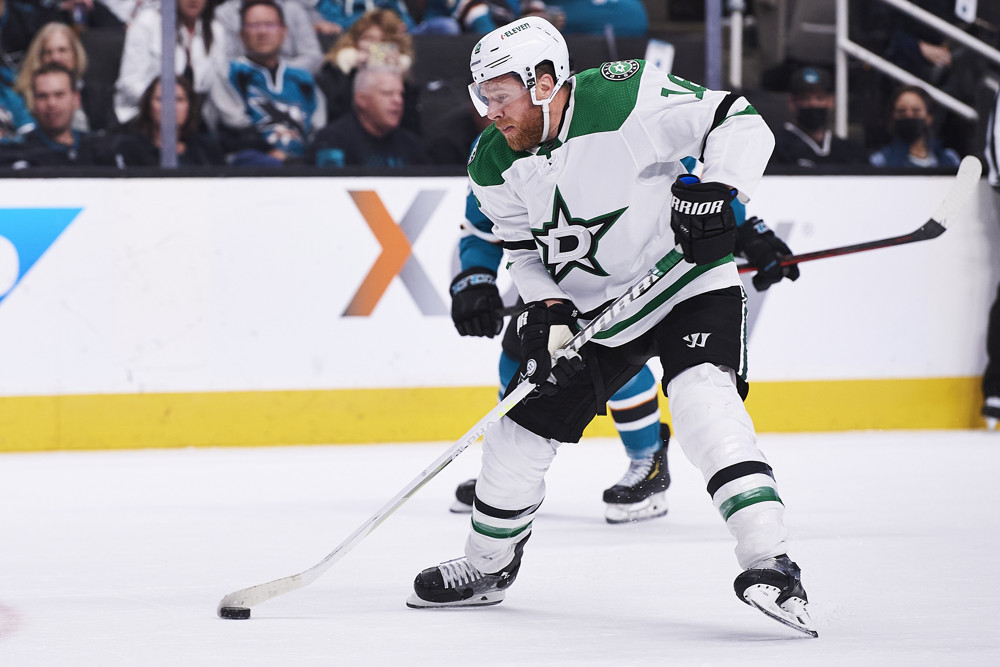How Joe Pavelski Is Keeping Up With the Dallas Stars’ Young Guns
In the final stage of Joe Pavelski’s NHL career, he’s carved out a spot on the Dallas Stars’ top line. Playing alongside dual-threat Jason Robertson (63 points in 60 games) and speedy scorer Roope Hintz (58 points in 66 games) has been a blessing, especially with the sophomore winger solidifying his status as one of the league’s brightest forwards.
Make no mistake, though: The 37-year-old is far from a mere passenger (68 points in 68 games).
The elder statesman remains an invaluable three-zone contributor who is leading the Stars’ youngsters by example. Sure, he can’t keep up with Hintz’s blistering pace or protect the puck as effectively as the 6’3”, 200-pound Robertson, but he never depended on his physical tools to begin with. Consequently, he hasn’t really lost a step in his 16th professional campaign. His net-front ability, sound positioning and strong decision-making are all proving vital to a 39-26-3 Stars club that’s vying for a wild-card berth in the Western Conference.
As gifted with the puck as Robertson and Hintz are, they aren’t quite as sharp without it. Pavelski brings the structure and stability required for his linemates to excel. He’s perpetually where he needs to be on the ice, which allows the Stars to find their bearings and avoid spending too much time in their end. It’s not about unbridled hustle. It’s about knowing how to help in any given situation:
On the strength of his instincts, Pavelski is often first to loose pucks. Those clean retrievals defuse the opposition’s pressure and facilitate Dallas’ breakout. Meanwhile, his wealth of experience makes his pathing ruthlessly efficient. Though he can’t skate with the fastest players around, he understands which line to take in order to deny them prime real estate.
Also, as perhaps the single best net-front weapon of the past decade, he recognizes optimal shooting lanes and does a great job of clogging them up by any means necessary. Pavelski’s ridiculous hand-eye coordination comes in handy on defense as well, as he breaks up passes or deflects pucks to safety on a regular basis. His faceoff performance has dipped slightly, but he’s still winning 51.8% of his draws too.
There’s a textbook quality to his two-way game. It’s reliable. Studied. He’s seemingly always in the right place at the right time.
Pavelski’s hockey sense is equally evident in Dallas’ transitional play. When he has the puck, he does well to detect his outlets or buy time for his ducks to get in a row. When he’s off the puck, he continually finds his way back to it, sealing the wall to regain possession and then instantly claiming inside leverage on his defender:
Due to his poor mobility, he can’t afford to play selfish hockey. His smarts and commitment to a team game are plain to see. He frequently sets the table for the Stars, making a simple pass that shifts the opposition’s posture and opens the door for an even better setup down the line. Better yet, he seldom forces the issue or throws pucks away for free. He’s willing to let plays develop in due course.
Combined with Robertson’s dizzying talent and Hintz’s trigger-happiness, Pavelski’s patience and cleverness have yielded spectacular results. Dallas’ top line is registering 3.33 expected goals and 3.77 actual goals per 60 minutes at 5-on-5. When they’re off the ice, the Stars’ xGF60 and GF60 tumble to 2.16 and 1.70, respectively.
In other words, they’re utterly carrying the attack. Of course, when discussing Pavelski’s offensive contributions, we have to highlight his net-front exploits:
His knack for tipping shots is obviously impressive, but he doesn’t get the credit he deserves for his close-quarters details. He knows precisely where to position himself depending on how the defense plays him and what Dallas is hoping to achieve. He can take away the goaltender’s sightline and look for a deflection, battle for a rebound or sneak to the side of the net for a tap-in opportunity. And he seamlessly moves from one mode to the next, so keeping tabs on him is a nightmare.
Moreover, his timing is incredible. He’ll swivel off his man when he anticipates a rebound or will slow down and trail the pack, lulling defenders to sleep before he pounces on a stray puck in the slot. A serious level of craft goes into his greasy goals.
Considering his usage, he also needs the pure skill to play with top-flight linemates. He’s always possessed that, and though the sport keeps speeding up, it never appears too fast for him on account of his processor. He boasts great vision, soft hands and a quick release, so he has no problem creating or capitalizing on chances:
Playing in between two ascending stars could make a 16-year vet look like a sore thumb, but Pavelski’s steady and time-tested game fits their dynamism to a tee. They can focus on splash plays, while he helps them connect the dots across all 200 feet of the rink. You can’t complain about his finish or playmaking either. This chemistry has generated the most high-danger looks and expected goals Pavelski has enjoyed in years. He’s setting a career-high in even-strength points/60. He’s sitting on one of the finest age-37+ seasons ever…and there are 14 games remaining on the schedule.
The Stars clearly believe he has plenty left in the tank too, as they recently signed him to a one-year extension worth $6 million. They’re probably right. As 2021-22 has shown us, he isn’t ready to hang them up yet because he can still hang with the best.
Recent Posts

How Corey Perry Is Making His Presence Felt With the Lightning
View Post »
How Adam Fox Pushed the Rangers Past the Penguins
View Post »

